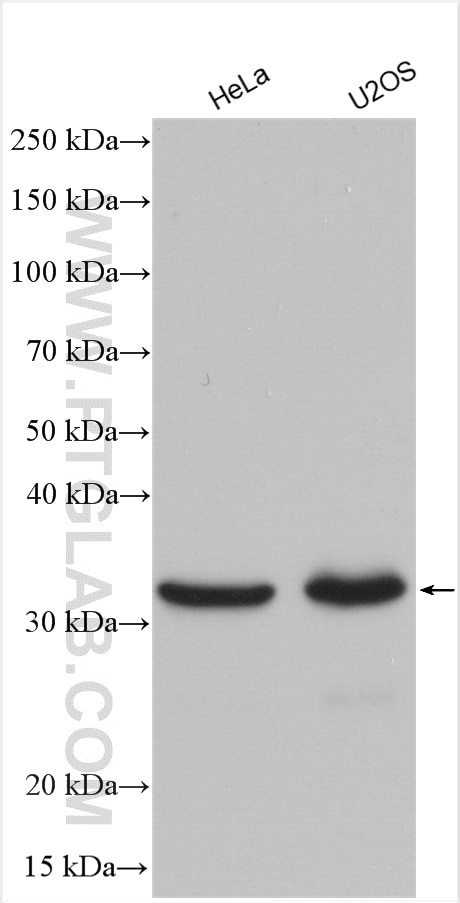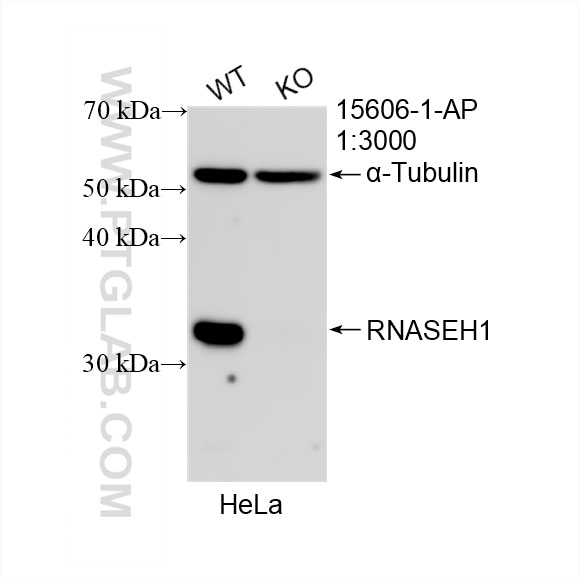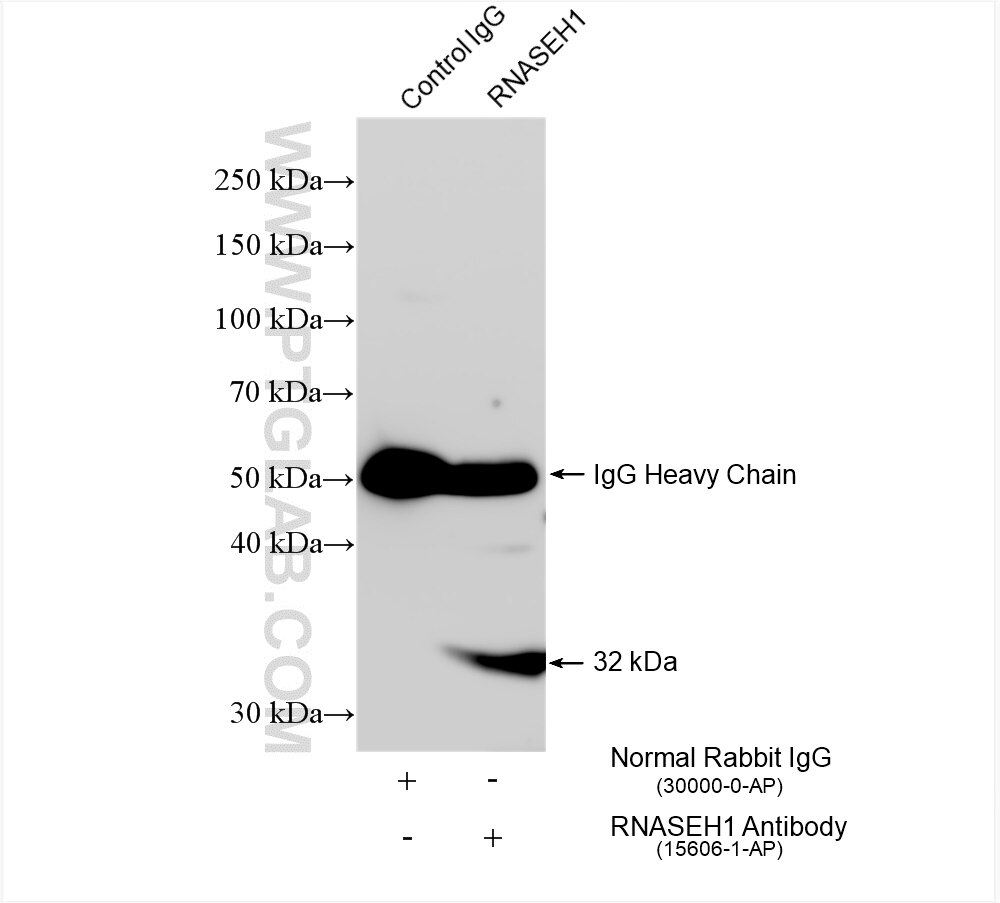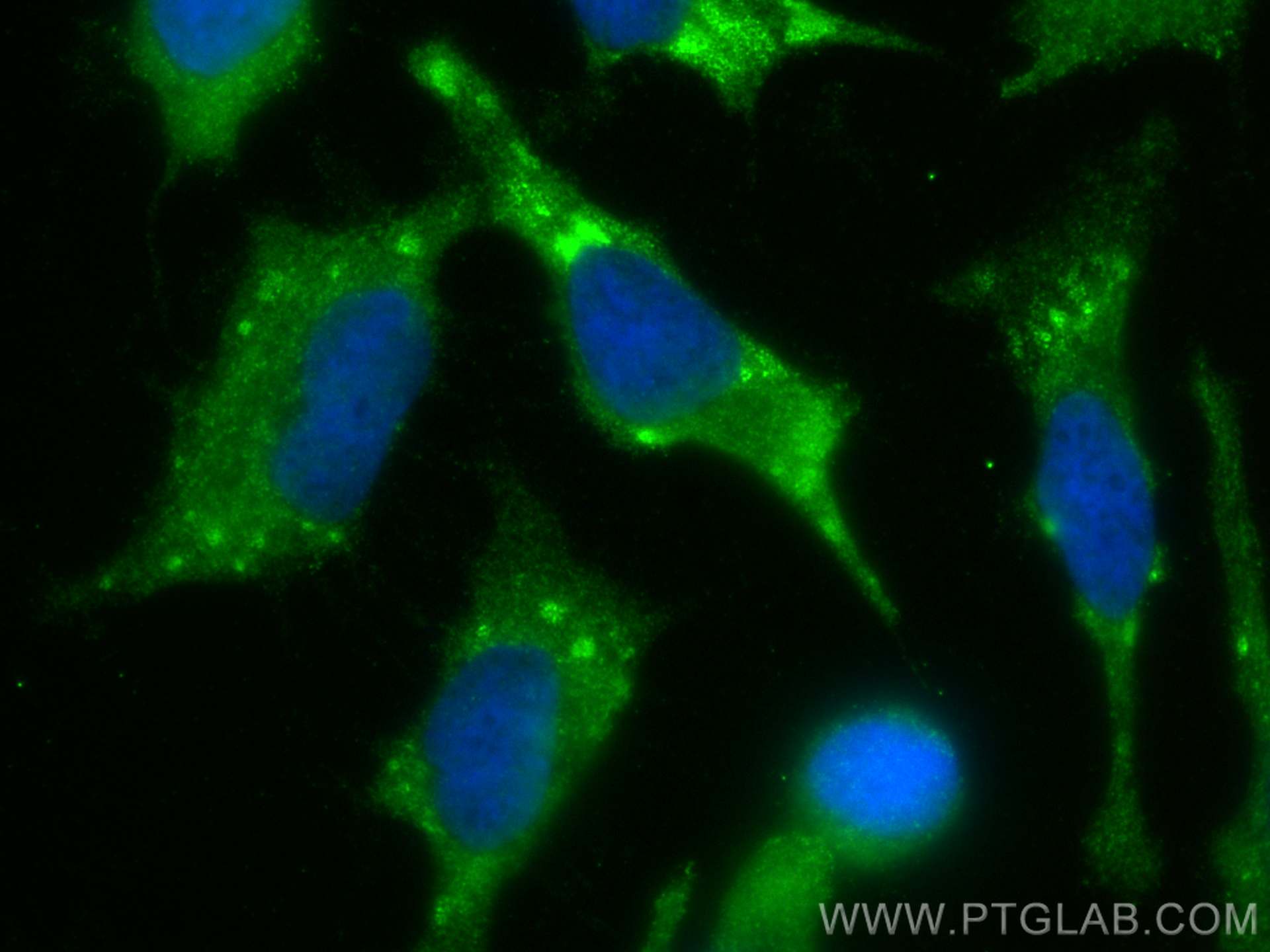- Featured Product
- KD/KO Validated
RNASEH1 Polyklonaler Antikörper
RNASEH1 Polyklonal Antikörper für WB, IF/ICC, IP, ELISA
Wirt / Isotyp
Kaninchen / IgG
Getestete Reaktivität
human, Maus, Ratte
Anwendung
WB, IHC, IF/ICC, IP, ChIP, ELISA
Konjugation
Unkonjugiert
Kat-Nr. : 15606-1-AP
Synonyme
Geprüfte Anwendungen
| Erfolgreiche Detektion in WB | HeLa-Zellen, U2OS-Zellen |
| Erfolgreiche IP | HeLa-Zellen |
| Erfolgreiche Detektion in IF/ICC | HeLa-Zellen |
Empfohlene Verdünnung
| Anwendung | Verdünnung |
|---|---|
| Western Blot (WB) | WB : 1:1000-1:5000 |
| Immunpräzipitation (IP) | IP : 0.5-4.0 ug for 1.0-3.0 mg of total protein lysate |
| Immunfluoreszenz (IF)/ICC | IF/ICC : 1:50-1:500 |
| It is recommended that this reagent should be titrated in each testing system to obtain optimal results. | |
| Sample-dependent, check data in validation data gallery | |
Veröffentlichte Anwendungen
| KD/KO | See 4 publications below |
| WB | See 37 publications below |
| IHC | See 2 publications below |
| IF | See 20 publications below |
| ChIP | See 1 publications below |
Produktinformation
15606-1-AP bindet in WB, IHC, IF/ICC, IP, ChIP, ELISA RNASEH1 und zeigt Reaktivität mit human, Maus, Ratten
| Getestete Reaktivität | human, Maus, Ratte |
| In Publikationen genannte Reaktivität | human, Maus |
| Wirt / Isotyp | Kaninchen / IgG |
| Klonalität | Polyklonal |
| Typ | Antikörper |
| Immunogen | RNASEH1 fusion protein Ag7990 |
| Vollständiger Name | ribonuclease H1 |
| Berechnetes Molekulargewicht | 32 kDa |
| Beobachtetes Molekulargewicht | 32 kDa |
| GenBank-Zugangsnummer | BC002973 |
| Gene symbol | RNASEH1 |
| Gene ID (NCBI) | 246243 |
| Konjugation | Unkonjugiert |
| Form | Liquid |
| Reinigungsmethode | Antigen-Affinitätsreinigung |
| Lagerungspuffer | PBS with 0.02% sodium azide and 50% glycerol |
| Lagerungsbedingungen | Bei -20°C lagern. Nach dem Versand ein Jahr lang stabil Aliquotieren ist bei -20oC Lagerung nicht notwendig. 20ul Größen enthalten 0,1% BSA. |
Hintergrundinformationen
Ribonucleases H are enzymes that cleave the RNA of RNA/DNA hybrids that form during replication and repair and which could lead to DNA instability if they were not processed. Eukaryotic RNases H are larger and more complex than their prokaryotic counterparts [PMID:12667461]. Eukaryotic RNase H1 has acquired a Hybrid Binding Domain that confers processivity and affinity for the substrate. Because of its essential role and its similarities in structure and enzymatic mechanism to the RNase H of HIV reverse transcriptase, RNASEH1 has been implicated in mitochondrial DNA replication during mouse development [PMID:19228196].
Protokolle
| PRODUKTSPEZIFISCHE PROTOKOLLE | |
|---|---|
| WB protocol for RNASEH1 antibody 15606-1-AP | Protokoll herunterladen |
| IF protocol for RNASEH1 antibody 15606-1-AP | Protokoll herunterladen |
| IP protocol for RNASEH1 antibody 15606-1-AP | Protokoll herunterladen |
| STANDARD-PROTOKOLLE | |
|---|---|
| Klicken Sie hier, um unsere Standardprotokolle anzuzeigen |
Publikationen
| Species | Application | Title |
|---|---|---|
Nature EWS-FLI1 increases transcription to cause R-loops and block BRCA1 repair in Ewing sarcoma. | ||
Cell Counteracting chromatin effects of a splicing-correcting antisense oligonucleotide improves its therapeutic efficacy in spinal muscular atrophy. | ||
Nature BRCA2 prevents R-loop accumulation and associates with TREX-2 mRNA export factor PCID2.
| ||
Cell Res Endogenous reverse transcriptase and RNase H-mediated antiviral mechanism in embryonic stem cells. | ||
Nat Cell Biol Damage-induced lncRNAs control the DNA damage response through interaction with DDRNAs at individual double-strand breaks. | ||
Rezensionen
The reviews below have been submitted by verified Proteintech customers who received an incentive for providing their feedback.
FH Mulavini (Verified Customer) (09-23-2024) | Works good
|
FH R (Verified Customer) (06-15-2024) | Excellent antibody working on WB (1/1000) and Immunofluorescence (1/250) with HeLa cells
|
FH Andrea (Verified Customer) (10-05-2023) | Strong signal, very good detection.
|
FH Huai-Chin (Verified Customer) (06-08-2019) | Very good antibody. I've tried it in Western blot, cultured cell immunofluorescence, and tissue IHC. All works well.
|





